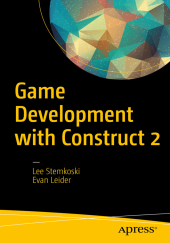 Neuerscheinungen 2017Stand: 2020-02-01 |
Schnellsuche
ISBN/Stichwort/Autor
|
Herderstraße 10
10625 Berlin
Tel.: 030 315 714 16
Fax 030 315 714 14
info@buchspektrum.de |

Evan Leider, Lee Stemkoski
(Beteiligte)
Game Development with Construct 2
From Design to Realization
1st ed. 2017. xxi, 240 S. 219 Farbabb. 235 mm
Verlag/Jahr: SPRINGER, BERLIN; APRESS 2017
ISBN: 1-484-22783-2 (1484227832)
Neue ISBN: 978-1-484-22783-1 (9781484227831)
Preis und Lieferzeit: Bitte klicken
Design and create video games using Construct 2. No prior experience is required. Game Development with Construct 2 teaches you to create 12 different game projects from a variety of genres, including car racing and tower defense to platformer and action-adventure. The software is user friendly and powerful, and the games you create can be exported to run on the web, desktop computers, and smartphones.
What You´ll Learn
Create complete functional games using the Construct 2 game engine
Understand general logical structures underlying video game programs
Use practical game design advice (such as visual feedback and gameplay balancing)
Understand programming concepts useful throughout computer science
Who This Book Is For
Middle school and high school students with no prior programming knowledge, and only minimal mathematical knowledge (graphing (x,y) coordinates, measuring angles, and applying formulas)
Chapter 1: Getting Started with Construct 2
About the Construct 2 game engine (we discuss how game engines compare to traditional creating games using traditional game programming languages, and the advantages to using the Construct 2 game engine in particular vs. other game engines)
Downloading and installing (we explain how to set up the software, and include a comparison between the free and licensed versions. Note: all programs developed in this book use features available in the free version.)
The user interface (we include a screenshot of the Construct software and explain the purpose of each panel, how to navigate between panels, and explain the basic terminology used by the program. All terms will be re-explained when they are first encountered in subsequent chapters)
Saving and exporting games (we describe the two ways a game can be saved, and the numerous export options (HTML5 website, app stores, executable files, etc.)
Chapter 2: Starfish Collector
Introduction (this section, common to most chapters, will include: - a screenshot and description of the game in terms of mechanics/dynamics/aesthetics - a list of previously covered topics the reader needs to remember and use here - a brief description of the new features of Construct that will be introduced in this chapter - initial project setup, graphics needed, and settings (window and layout size, renaming layouts and layers, etc.)
Sprites (adding objects to the game; using the image editor; changing position, angle, and size)
Events (the "code" of Construct; events are "if"-statements: conditions followed by actions; event-driven programming; how to make the starfish disappear on contact; adding comments)
Behaviors (pre-programmed sets of events to accelerate game development; 8-directional movement and keeping the player on the screen)
Ending the game (organizing messages with a User Interface layer; accessing properties in code; system conditions)
Side Quests (this section, common to most chapters, will include optional extra modules the reader can follow that introduce additional game mechanics or add polish to the game, and an "on your own" section with ideas that the reader can implement on their own to practice and refine their skills)
solid objects (add a rock sprite, introduce solid behavior, collision polygons, rotate and scale to make duplicates appear different)
value-based animations (contrast value-based vs. image-based animations; discuss the importance of drawing player attention to interactive objects; adding the rotate, sine, and fade behaviors to animate the starfish)
on your own (creating a maze from the rocks; rotating solid objects; making the starfish change position with the sine behavior; adding additional sprites, like seaweed)
Chapter 3: Space Rocks (inspired by the classic game "Asteroids")
Introduces: Keyboard, Custom Movement, Bullet, Wrap, Animation (spritesheet; blending), Pin, functions
Introduction
Spaceship movement (discuss when one needs to write custom events rather than use behaviors; the keyboard object and custom movement and wrap behavior; velocity vs. acceleration; setting speed limits)
Lasers and rocks (introduce the bullet behavior, and image-based animations; contrast key down vs. key press conditions)
Thrusters and Explosions (the importance of visual feedback for the player; pin behavior)
Teleportation (introduction to functions, randomization)
Winning or losing the game
Side Quests
Shields (discuss game balance; decreasing the difficulty by allowing multiple collisions)
UFOs (introduces spawn points, periodic events, combining bullet and sine behaviors)
on your own (add a solid planet or moon; randomizing rock movement)
Chapter 4: Street Sweeper (inspired by the classic game "Frogger", the player (a street sweeper) needs to cross a busy road and pick up pieces of trash, avoiding cars along the way, then deposit the trash


